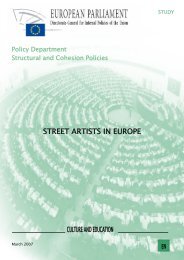MusLi (Museums Literacy) - Fondazione Fitzcarraldo
MusLi (Museums Literacy) - Fondazione Fitzcarraldo
MusLi (Museums Literacy) - Fondazione Fitzcarraldo
Create successful ePaper yourself
Turn your PDF publications into a flip-book with our unique Google optimized e-Paper software.
28 <strong>MusLi</strong> - No qualifications needed: museums and new audiences<br />
Monitor and evaluate the activities<br />
The evaluation of activities addressed to “new” and “hard to reach” audiences is fundamental in monitoring<br />
the achievement of expected outcomes and, having registered difficulties in the implementation,<br />
putting into practice the necessary improvements.<br />
For the nature of these activities, as they have been analysed here – that is to say contact, relationships<br />
and confidence building, listening to audiences (their representations, expectations and needs), the<br />
recording of the variable systems of constraints, dialogue and interaction – getting closer to irregular<br />
visitors will always be experimental and requires a high level of flexibility and adaptation to variable<br />
conditions.<br />
Becoming better at defining the initial objectives and noting the variations along the way is, therefore,<br />
a permanent learning process for the project managers themselves.<br />
It must be stressed that deviation from project objectives does not always represent a fault or a failure.<br />
The plurality of expectations and representations stated at the beginning of a project – those of the<br />
museum on the one hand and of audiences on the other – makes it impossible to anticipate or observe<br />
the final effects of the projects according to a set of given parameters.<br />
The consequent evaluation – especially if addressed to the impact of the activities on the participants,<br />
both internal or external to the museum – has to make use of qualitative methods and to adapt to the<br />
emergence of multiple and also unexpected results, which can lead to positive outcomes translated, in<br />
a retroactive way, into a change of attitudes and operational criteria of the museum itself.<br />
One of the merits of this project is, amongst others, to have carried out parallel and convergent evaluations<br />
on the different case studies illustrated here. It is clearly only an outline process, since the differences<br />
in methodologies have inevitably been retained and the amount of data at our disposal is really<br />
moderate, which does not allow us to draw definite conclusions.<br />
Cautions regarding the analysis of the target audiences<br />
Great caution has to be shown when choosing methodologies for observation of and consultation with<br />
these audiences, especially when particularly culturally deprived subjects are involved.<br />
The issue has long been investigated by sociological analysis 3 : reticence regarding specific aspects<br />
of cultural or cognitive discomfort or deficit, as well as a difficulty in understanding a set of questions<br />
can threaten the rigour of results produced by “traditional” tools of analysis, such as questionnaires or<br />
interviews, some of which have been used for the analysis of audiences in different cases illustrated<br />
here.<br />
Without opening up a debate into very complex and already broadly discussed issues, some recommendations<br />
are summarised below. They are shared by the project partners and at the heart of choices<br />
adopted in audience research carried out within <strong>Museums</strong> <strong>Literacy</strong>:<br />
3 See Kenneth D. Bailey, Methods of Social Research. New York: Free Press, 1978; Allen Rubin, Earl R. Babbie, Research Methods for Social Work, Belmont, CA:<br />
Wadsworth/Thompson Learning 2001 (5 th Ed.)






